Researcher: Steven, E2M Research
Looking back, the Ethereum futures ETF was a bit hasty. Ethereum is much more complicated than Bitcoin. The reason why Ethereum was rejected will definitely set an example for future crypto assets to apply for spot ETFs. However, in the traditional world, there are also ETF products for commodities with particularly wide application scenarios, such as pork ETFs and oil ETFs.
CM: Whether the spot ETF is approved or not does not depend on the technical level (POS or POW). The technical guidance is centralized, and the network is decentralized. If Ethereum cannot be approved, it means that subsequent crypto assets will basically not be approved, because from the perspective of decentralization, Ethereum is the second most decentralized product besides Bitcoin.
70% passed!!!
Dongzhen: ETH is not large in scale, and Grayscale and other project parties are not very driven. From the perspective of game theory, it is not as driven as Bitcoin spot ETF. There are no decisive events, such as BlackRocks first application for Bitcoin spot ETF and Grayscales victory in the court lawsuit.
50% !!! 50-50!!
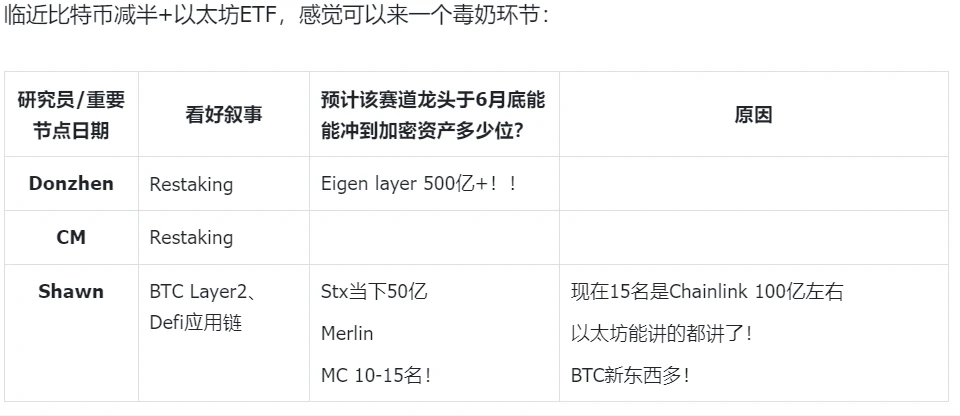
1. News
3.20
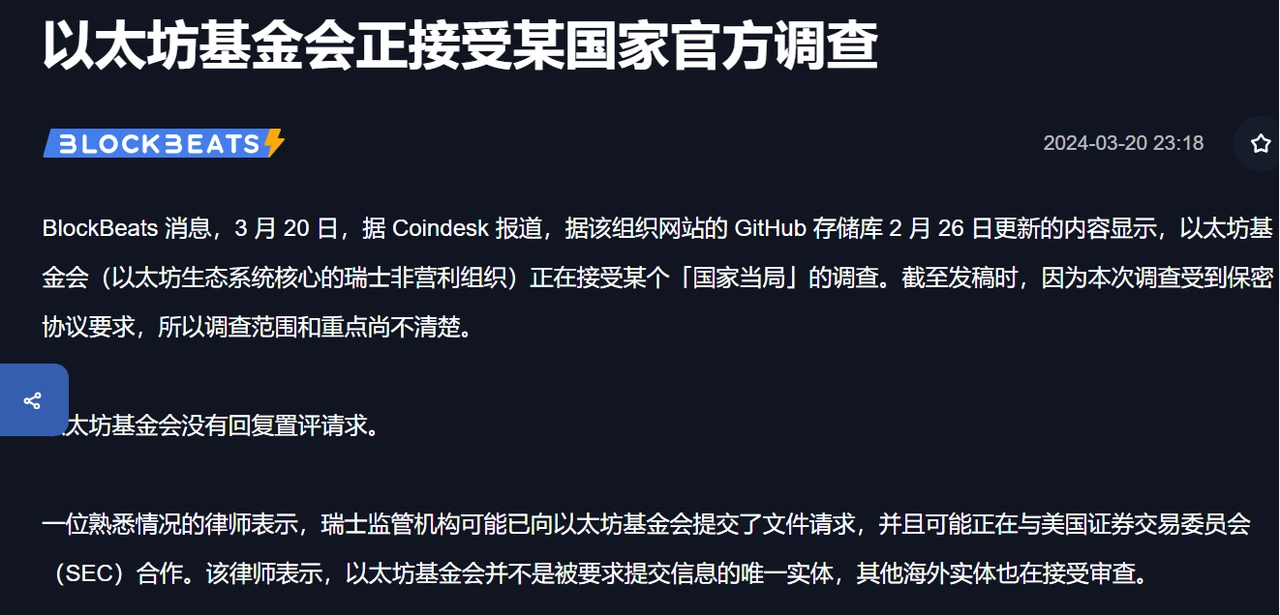
Link source: https://www.theblockbeats.info/flash/239194
2. Bitcoin related data
2.1 BTC spot ETF situation
There was net outflow for five consecutive days, but the total outflow began to narrow.
ETF Bitcoin holdings: 800,000
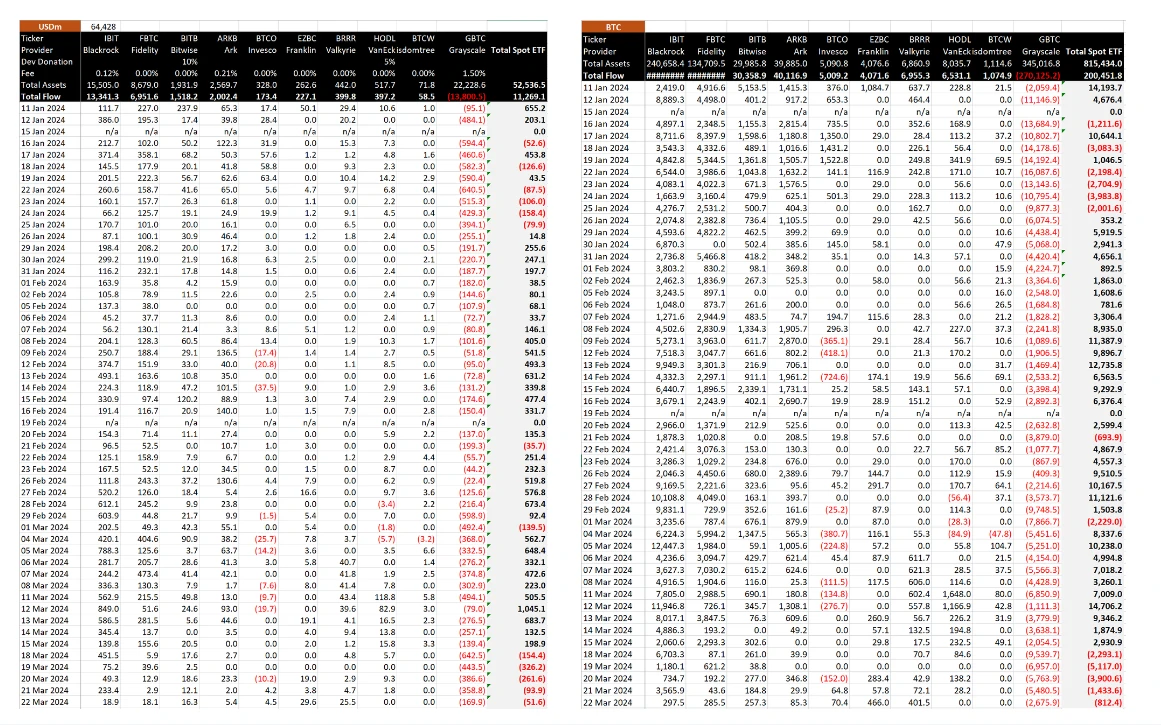
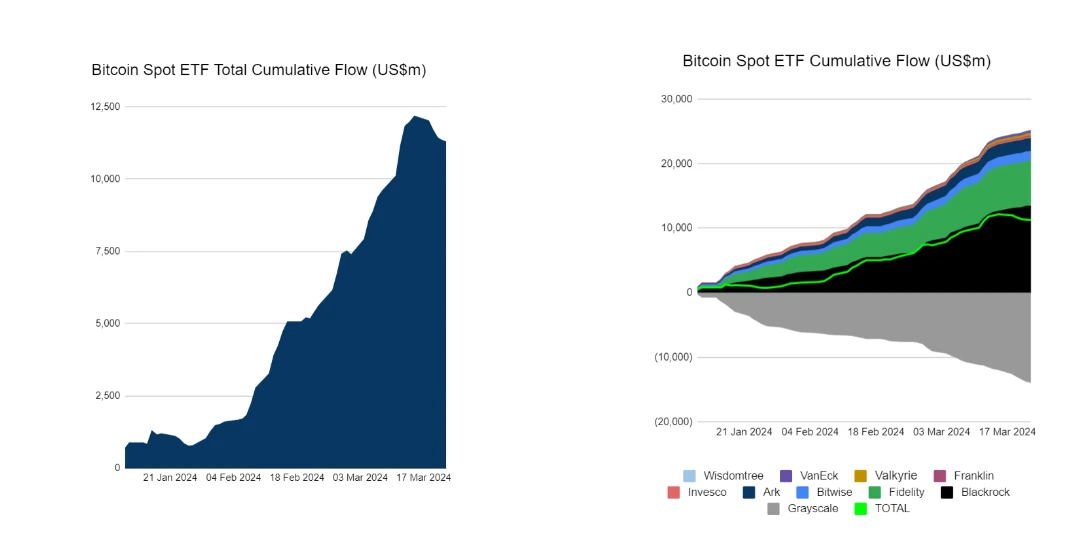
Data source: https://twitter.com/BitMEXResearch/status/1771466088066228227/photo/1
New ETF investors are strong, and selling pressure comes from other Bitcoin owners. Net inflows into the nine new (excluding GBTC) Bitcoin spot ETFs were about $1.2 billion in the past 5 days, but the price fell 8%. GBTC did have outflows, but it was mainly Genesis selling, but he just exchanged GBTC shares for spot BTC, so it was a neutral event. All in all, ETFs have been net buyers of BTC, and more money will come in.
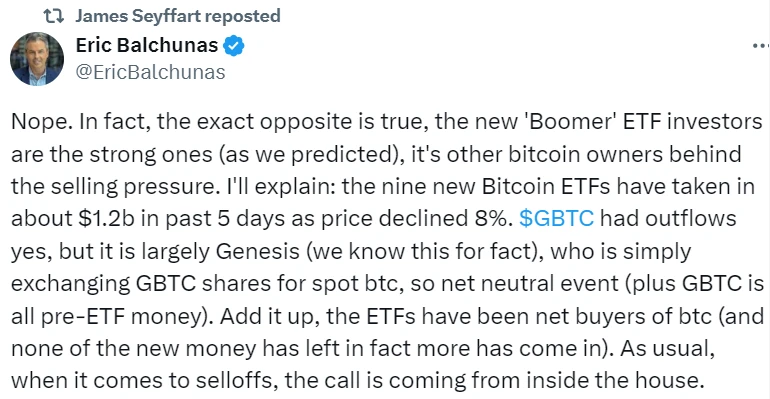
Text source: https://twitter.com/EricBalchunas
Replenish:
Cryptocurrency lending company Genesis declared bankruptcy last year, but on Wednesday, February 14, U.S. time, it received approval from the bankruptcy court to sell approximately 35 million shares of Grayscale Bitcoin Trust (GBTC) worth more than $1.3 billion. The proceeds from this transaction will be used to repay creditors.
2.2 Bitcoin Hold Waves
16.36% of Bitcoins have not been traded for more than 10 years, and most of these Bitcoins may be lost.
2100* 16.36% = 3.4356 million bitcoins

Data link: https://www.lookintobitcoin.com/charts/hodl-waves/
3. What are the reasons for rejecting the Ethereum spot ETF?
Ethereum Spot ETF Application Status
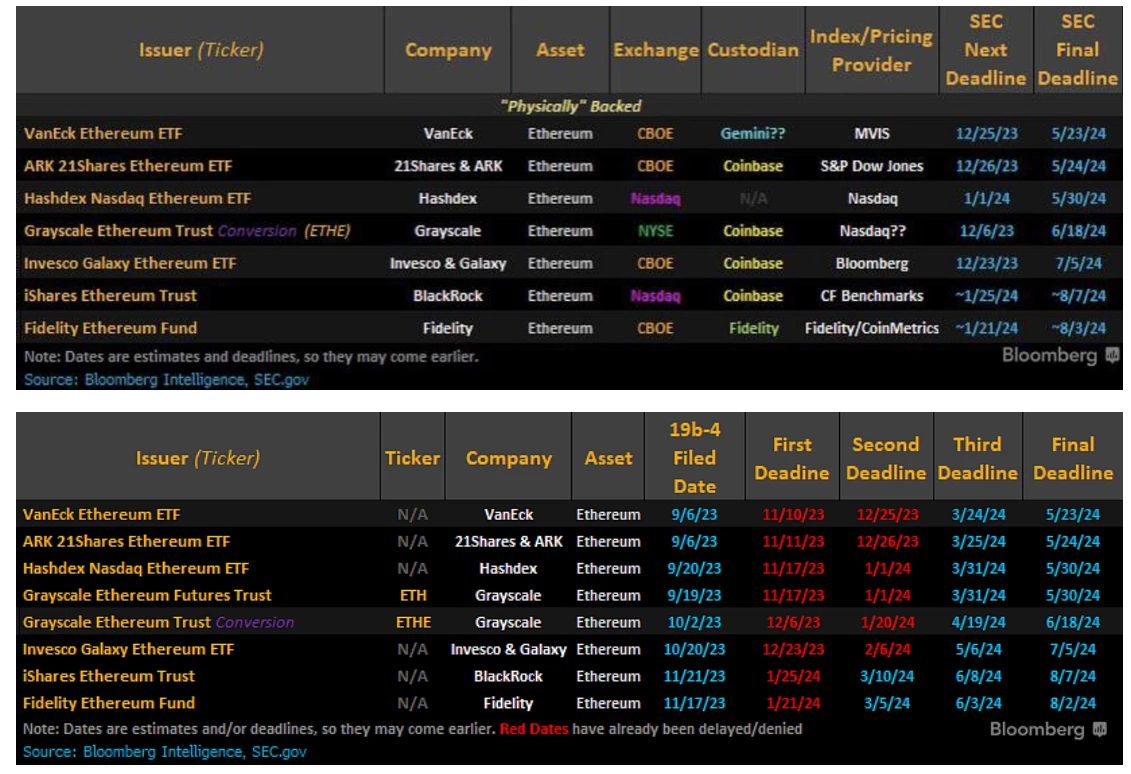
Ethereum is defined as a security

The Ethereum Foundation — the Swiss nonprofit at the heart of the Ethereum ecosystem — is facing questions from unnamed “national authorities,” according to a GitHub repository for the organization’s website.
The confidential survey comes at a time of technological change for Ethereum and a possible inflection point for its native ETH asset, with many U.S. investment firms looking to offer it as an exchange-traded fund. Despite recently approving a slew of bitcoin ETFs, the U.S. Securities and Exchange Commission’s (SEC) efforts have been slow.
After this article was published, Fortune reported that the SEC is looking to classify ETH as a security, a move that would have significant implications for Ethereum, ETH ETFs, and cryptocurrencies as a whole. According to Fortune, the financial regulator has issued investigative subpoenas to U.S. companies in the past few weeks.
If there is a suitable explanation that can define Ethereum as a security, then Ethereums current disclosure level and materials will definitely not pass. But Gary himself said in disguise that Ethereum is a commodity, not a security, and the Ethereum futures ETF has been approved.
In addition, if Ethereum is defined as a security and the supplementary materials are passed, it will have a demonstration effect on other cryptocurrencies that have been defined as securities, so it is not entirely a bad thing if it is not passed on May 24.
In the lawsuit against Coinbase, the SEC identified SOL, ADA, MATIC, FIL, SAND, AXS, CHZ, FLOW, ICP, NEAR, VGX, DASH, and NEXO tokens as securities.
In the lawsuit against Binance, the SEC listed SOL, ADA, MATIC, FIL, ATOM, SAND, MANA, ALGO, AXS, and COTI as securities.
The fact that cryptocurrencies are defined as both securities and commodities means that they will be subject to different regulatory frameworks and laws, depending on which they are classified as. This is important to understand because it will affect the way cryptocurrency businesses and investors operate, their profit models, and their compliance requirements.
Cryptocurrency as a security: When a cryptocurrency is defined as a security, it is usually based on the so-called Howey Test, a standard established by the U.S. Supreme Court for determining whether an investment is a security. If a cryptocurrency project involves investors funds being invested in a common enterprise with the expectation of gaining benefits through the efforts of others, then the cryptocurrency may be considered a security. As a result, it will be strictly regulated by the U.S. Securities and Exchange Commission (SEC) and other relevant financial regulators and must comply with a series of legal requirements including registration requirements, disclosure requirements and other investor protection regulations.
Cryptocurrency as a commodity: On the other hand, if cryptocurrencies are viewed more as commodities, such as Bitcoin and Ethereum, which are widely considered to be decentralized and not controlled by any specific entity, they are more likely to be considered a commodity. Commodities are generally defined as an underlying physical resource that can be traded, invested in, or consumed. In the United States, this means that they are regulated by the Commodity Futures Trading Commission (CFTC). This involves different rules and regulatory approaches, focusing on market integrity, prevention of manipulation and fraud, etc., rather than registration and disclosure requirements like securities.
Summary: Cryptocurrencies are classified as securities or commodities, which means they face different regulatory structures and compliance requirements. This classification affects how cryptocurrencies can be sold, traded and held, and how related businesses can operate. It is extremely important for investors and entrepreneurs to understand how cryptocurrencies are regulated and what this means for their obligations and responsibilities.
Ethereum spot ETF has not been discussed and communicated as frequently as the Bitcoin spot ETF in the months before it was approved.
The main basis for Bloombergs James Seyffarts judgment (one of the big names who predicted that the Bitcoin spot ETF would be approved) is that the SEC did not have frequent communication with those Ethereum spot ETF applicants like it did in the months before the Bitcoin spot ETF application was approved.
This is not a professional analysis.
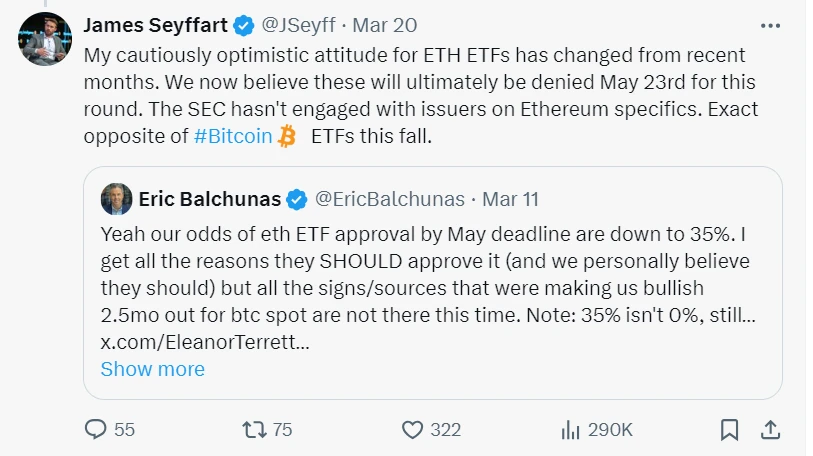
Personal speculation:
Is it possible that during the months of frequent discussions on the BTC spot ETF, most of the issues have been resolved, resulting in a high degree of duplication of materials when Issuers apply for the Ethereum spot ETF, so there is no need for too much discussion?
The SEC did not find strong evidence to refute it, just like it could not refute the approval of the BTC spot ETF.
Ethereum’s economic model is not an absolute deflationary model, nor is it absolutely decentralized.
Bitcoins economic model, in which the reward is halved when a certain number of blocks is reached, is an absolute deflationary model, but Ethereum is not.
Regarding the issue of Ethereum centralization, the only thing mentioned in the application materials for the Ethereum futures ETF is the price fluctuations caused by the Ethereum hard fork and the fluctuations of various financial products. In fact, I think this is a manifestation of the lack of thorough and comprehensive research on Ethereum. The degree of decentralization has a great weight on whether the product can be manipulated by the market.
Reference: Valkyrie ETF Trust II
Ethereums economic model is deflationary because every time a transaction occurs, a portion of the transaction fee is destroyed, resulting in a decrease in supply. If the number of transactions on the Ethereum network continues to increase, and the growth rate of transaction fees exceeds the destruction rate, then the total supply of Ethereum may begin to increase, and deflation will no longer occur. This may happen when the network activity increases, transaction fees increase, or other factors cause the destruction rate to be insufficient to offset the increase in supply.
For example, the period from August 2023 to November 2023 in the figure.

Image source: https://ultrasound.money/
If we dig deeper, we will find that the transition from Ethereum PoW to PoS is not controllable by the SEC, but is decided by the Ethereum Foundation headed by Vitalik Buterin. One of the most extreme things about Bitcoin is the complete delegation of power to the founding team. To this day, no one knows who Satoshi Nakamoto is.
This means that Ethereum can actually manipulate the progress of inflation/deflation through some methods, such as:
EIP-1559 changes: EIP-1559 is a proposal on the Ethereum network that introduces the concept of a base fee and uses it to destroy ETH. If the implementation of EIP-1559 is adjusted in the future, such as reducing the destruction ratio or completely canceling the destruction mechanism, the supply of Ethereum will no longer decrease.
Changes in the issuance mechanism: The issuance of Ethereum is controlled by many factors, including mining rewards, staking rewards, etc. If the issuance mechanism of Ethereum changes in the future, such as increasing mining rewards or adjusting staking rewards, the supply of new ETH will increase, which may also stop Ethereums deflationary trend.
Technology or protocol updates: The Ethereum community may update the protocol through hard forks or soft forks, and these updates may affect the supply and destruction mechanism of ETH. For example, if new technology emerges that can reduce transaction costs or change the way transaction fees are distributed, it may affect the supply of ETH.
Jokingly speaking, is LTC easier to pass? In a sense, it is true.
Both PoS and PoW have the risk of being manipulated by the market, and neither is better than the other (and the less environmentally friendly PoW has already been approved)
Proof of Stake (PoS) and Proof of Work (PoW) are two different consensus mechanisms, each with its own characteristics in resisting market manipulation.
In the PoS system, validators must lock up a certain amount of tokens as collateral to participate in the generation and verification of blocks. If validators attempt to cheat or engage in malicious behavior, their collateralized tokens may be confiscated, which is called slashing. This mechanism can theoretically improve the integrity of validators because they have a greater economic incentive to maintain the security and stability of the network. Therefore, compared to PoW, PoS may be more difficult to suffer from a single entity controlling the network through computing power in some cases.
However, PoS systems also face their own risks of manipulation. For example, if a validator or a small number of validators hold a large amount of staked tokens, they may gain disproportionate control over the network, which is known as staking centralization. This centralization can lead to excessive concentration of power, which increases the risk of manipulation. In addition, because validators in PoS systems are often rewarded with transaction fees and/or newly minted tokens, this may attract wealthy individuals or entities to participate, further exacerbating the centralization problem.
In the PoW system, miners compete to generate new blocks by solving complex mathematical puzzles, a process that consumes a lot of computing resources and energy. In theory, the PoW system resists manipulation through decentralized computing power distribution, because any attempt to control a majority of the network computing power will be very expensive and difficult to achieve. However, if a group of miners (mining pool) controls more than 50% of the network computing power, they have the ability to conduct a double-spending attack, that is, confirming two different transaction branches at the same time, thereby undermining the security and integrity of the network.
In general, both PoS and PoW have their own advantages and disadvantages, and both have potential market manipulation risks. The choice of which consensus mechanism to use depends more on the communitys preferences, the specific needs of the project, and the trade-off between security and decentralization.
Of course, apart from Ethereum, any project other than Bitcoin basically has insufficient decentralization. Many people think that SOL will be the next after the Ethereum spot ETF is passed, but no one has mentioned that Solana nodes are all enterprise-level nodes, and the possibility of doing evil is far greater than Ethereum. This also does not take into account that the possibility of Ethereum doing evil is already far greater than Bitcoin.
4. Grayscale
4.1 About ETHEs latest application
Grayscale requirements:
Allow ETHE redemption (in other words, spot ETF)
Allow Ethereum in trusts to be staked (this is more radical)
14 A refers to the U.S. Securities and Exchange Commission (SEC) Form 14A, which is a specific form of document, commonly known as a proxy statement. A company must file this document with the SEC and send it to its shareholders when it is preparing to hold a shareholder meeting or any matter that requires a shareholder vote. The proxy statement provides detailed information about the upcoming meeting and voting matters, including but not limited to:
Upcoming Board of Directors
Executive Officer Compensation Information
Major decision proposals, such as mergers, acquisitions, changes to company charters, etc.
Board Recommended Voting Guidelines
Corporate governance related information
Potential conflicts of interest or other important information about a companys management. The purpose of a proxy statement is to ensure that shareholders have adequate information when making voting decisions. This is a mechanism under the U.S. securities law framework to protect investor interests and ensure transparency in corporate governance. This transparency required by the SEC helps shareholders make informed decisions about the company.
Grayscale’s latest 14 A, the GRAYSCALE ETHEREUM ETF, enables the Trust to pledge Ethereum held by the Trust and receive consideration associated therewith to achieve the ultimate benefit of ETHE shareholders.
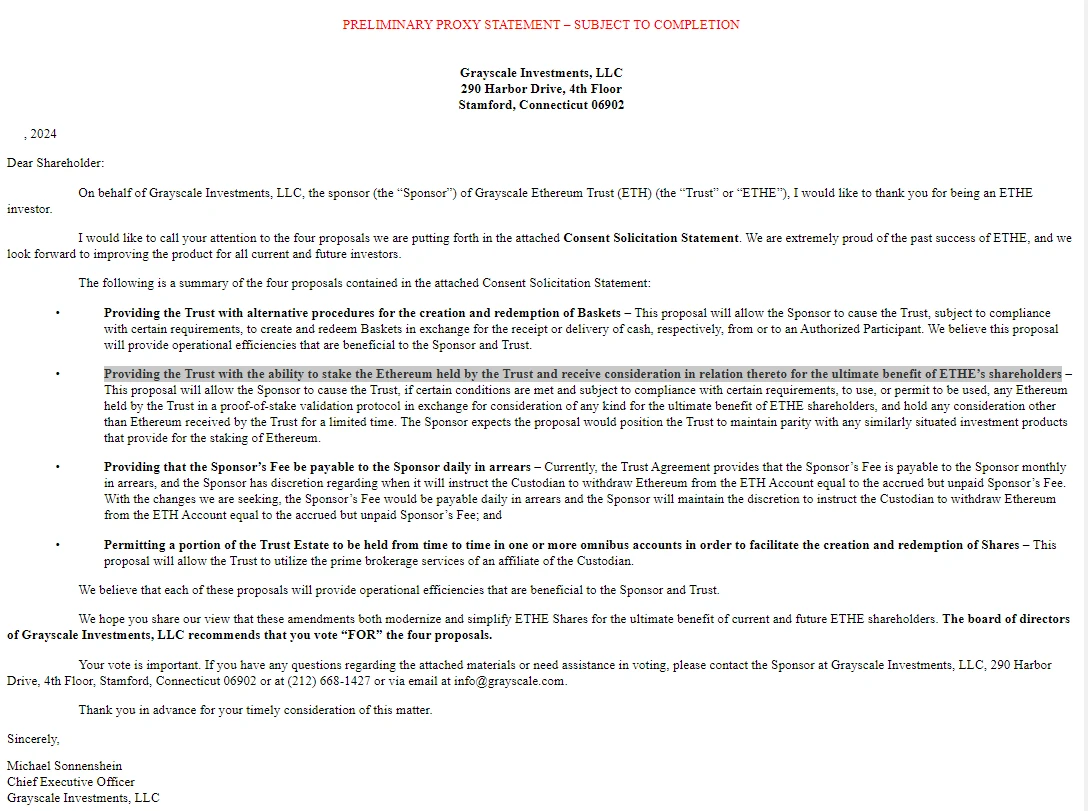 Link: https://www.sec.gov/Archives/edgar/data/1725210/000095017024033515/ethe_pre_14a.htm
Link: https://www.sec.gov/Archives/edgar/data/1725210/000095017024033515/ethe_pre_14a.htm
ETHE is worth less than $10 billion (compared with Grayscales peak Bitcoin market value: 600,000 * 70,000 = 420 billion U.S. dollars, current market value: 350,000 * 70,000 = 245 billion U.S. dollars). It can be seen that the impact of the approval of the ETF spot on the market may not be so severe.

4.2 Bitcoin holdings
Grayscales Bitcoin holdings have dropped from an initial 600,000 to 350,000.
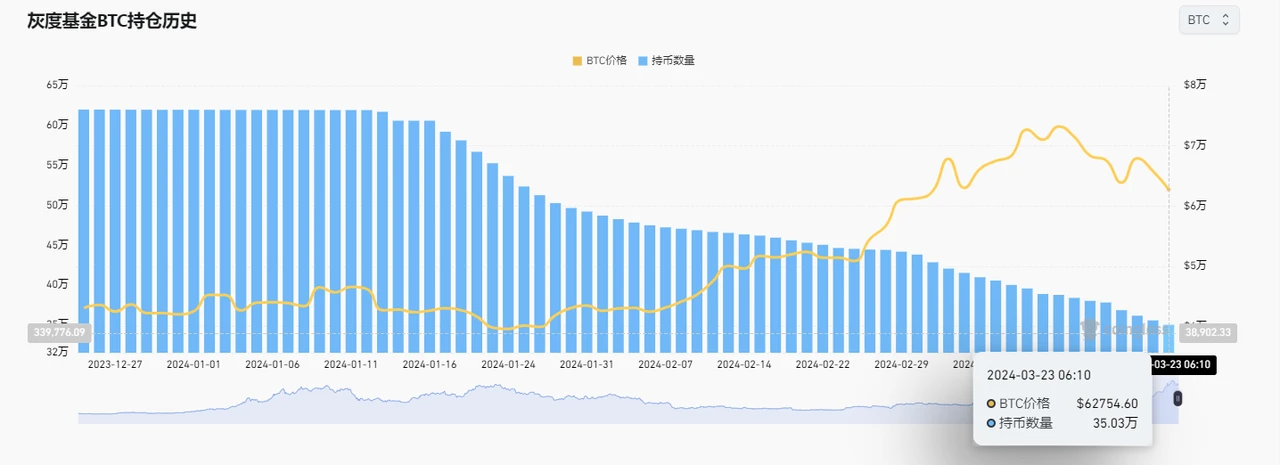
Data source: https://www.coinglass.com/zh/Grayscale
About E2M Research
From the Earth to the Moon E2M Research focuses on research and learning in the fields of investment and digital currency.
Article collection: https://mirror.xyz/0x80894DE3D9110De7fd55885C83DeB3622503D13B
Follow us on Twitter: https://twitter.com/E2mResearch ️
Audio podcast: https://e2m-research.castos.com/
Xiaoyuzhou link: https://www.xiaoyuzhoufm.com/podcast/ 6499969 a 932 f 350 aae 20 ec 6 d
DC Link: https://discord.gg/WSQBFmP772










